Pendo vs Whatfix: Which is Better For Customer Feedback
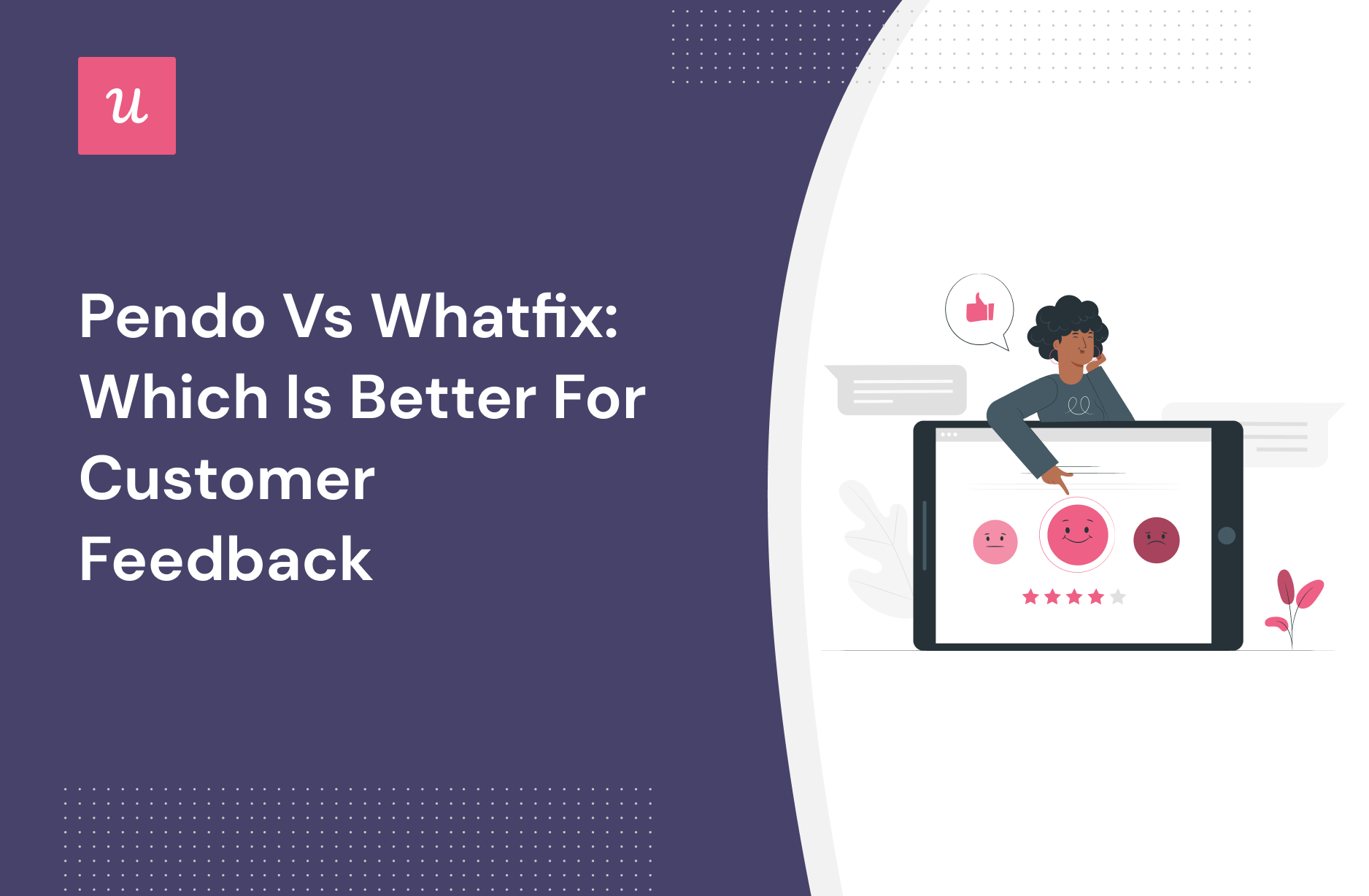
Is Pendo or Whatfix the best tool for customer feedback? And is there an alternative in-app feedback software that delivers the best value for money?
With so many user feedback tools available on the market today, it can be challenging to pick the right one for your needs. You need to not only consider your priorities, and the features you need to achieve your goals but also find the one that is aligned with your budget.
In this post, we’ll discuss exactly that – what the perfect software for customer feedback should deliver and which will be the best choice for your company’s needs.
Let’s get started!
TL;DR
-
Customer feedback refers to qualitative and quantitative insights gleaned from actual users about their likes, dislikes, requests, and impressions of your product.
-
Collecting and analyzing customer feedback is crucial for businesses that want to enhance the product experience and improve customer satisfaction. Your customers’ honest insights can reveal where you fall short and what you can do to better meet their expectations.
- Using tools, non-technical people such as product managers or customer success managers can collect and analyze user feedback at scale, without having to rely on developers.
- A good customer feedback tool must have certain features: 1) the ability to create different types of in-app surveys, 2) customize surveys to match company branding, and 3) create segments based on responses to deliver customized experiences.
- Pendo and Whatfix are popular product adoption tools also commonly used for collecting customer feedback in-app.
-
Pendo is an expensive tool for product adoption that offers polls (also called micro surveys) through its guides. This allows you to collect user feedback and gauge sentiment at different points in the user journey. However, there is one big problem with pools: they don’t offer customization options(no themes, no emojis).
- If you want to measure user sentiment with NPS surveys, you have to purchase the Growth plan, which is rather expensive, by the way. However, even with the paid plan NPS functionalities are limited: you can’t segment users on NPS scores and leverage NPS data to drive loyalty for each group.
- With Whatfix, you can create in-app surveys, collect feedback on the onboarding tours and training flows, add a follow-up question to enable open-minded feedback, and send push reminders to customers so they don’t forget about providing feedback.
- With that being said, Whatfix isn’t a perfect tool: it does a poor job when it comes to analytics and customization.
- Neither Pendo nor Whatfix is exactly what you’re looking for? Consider Userpilot, the perfect alternative for collecting and analyzing customer feedback in-app. You can use survey templates out of the box, customize them to fit your brand and UI, and trigger them contextually using segmentation. Get a Demo to see it in action.
![]()
Looking for the best tool for customer feedback? Search no more!

What is customer feedback?
Customer feedback is any information provided by customers about their experience with a product or service. By analyzing customer feedback, you can reveal their level of satisfaction and pinpoint areas for improvement.
Why should you care about customer feedback?
Customer feedback is important if you want to truly serve your customers and come up with solutions that can solve their pain points.
Here is why customer feedback matters:
- Understand whether customers see value in your product and if it meets their needs
- Uncover weak spots of your product and bottlenecks that disturb the customer journey
- Make your customers voices heard and acknowledge them that they are important to you
- Collect real-time insights on the go as you’re introducing new features or product updates
Why do you need tools for customer feedback?
Wondering why you even need a customer feedback tool? There are several reasons why you may need one:
Collecting customer feedback should be a standard procedure for any product team. It should be consistent and gained across different stages of the customer journey so you can measure customer experience in different situations. This might be time-consuming but thanks to customer feedback tools, the process can be hassle-free and literally without any coding.
Here’s how customer feedback tools help.
- Create different forms of microsurveys, such as NPS, CSAT, CES, PMF to collect contextual feedback
- Customize the surveys so they are aligned with your brand and match the interface of your app
- Segment customers by their feedback so you can create personalized flows for them
- Conduct a user sentiment analysis to understand your customers better
Now you might ask yourself, how to choose the right customer feedback tool for your SaaS? This is what we will be discussing next.
Must-have features of a customer feedback tool
Before deciding which customer feedback tool works best, you should understand what features any solid tool must provide.
Here’s what to look for before making a buying decision:
- Make sure the tool you choose supports multiple forms of microsurveys. The most important and popular ones for collecting customer feedback include the Net Promoter Score, Customer satisfaction score, Customer effort score, product-market fit survey, etc
- You should also get customization capabilities so that the surveys you create match your interface and don’t look odd. No tool branding is also preferable
- Feedback analytics and response monitoring are the next key features if you want to not only collect feedback but also analyze it and understand the intent behind your customers’ scores.
- Integration with 3rd party survey and analytics tools so you can enrich your surveys to make the most out of the customer feedback
There you have it. These are the basic features you should be looking for, but the tool you should go with must be dependent on your specific goals. You might need a tool that must cover all of these features but if you don’t need complex features, you should be completely ok with a tool with limited functionalities.
Pendo for customer feedback
Pendo is a comprehensive digital adoption platform with impressive analytics, in-app feedback, and product adoption features
It caters primarily to enterprise users and probably has the most advanced analytics of all tools we’re covering in this article. But it all comes at a price.
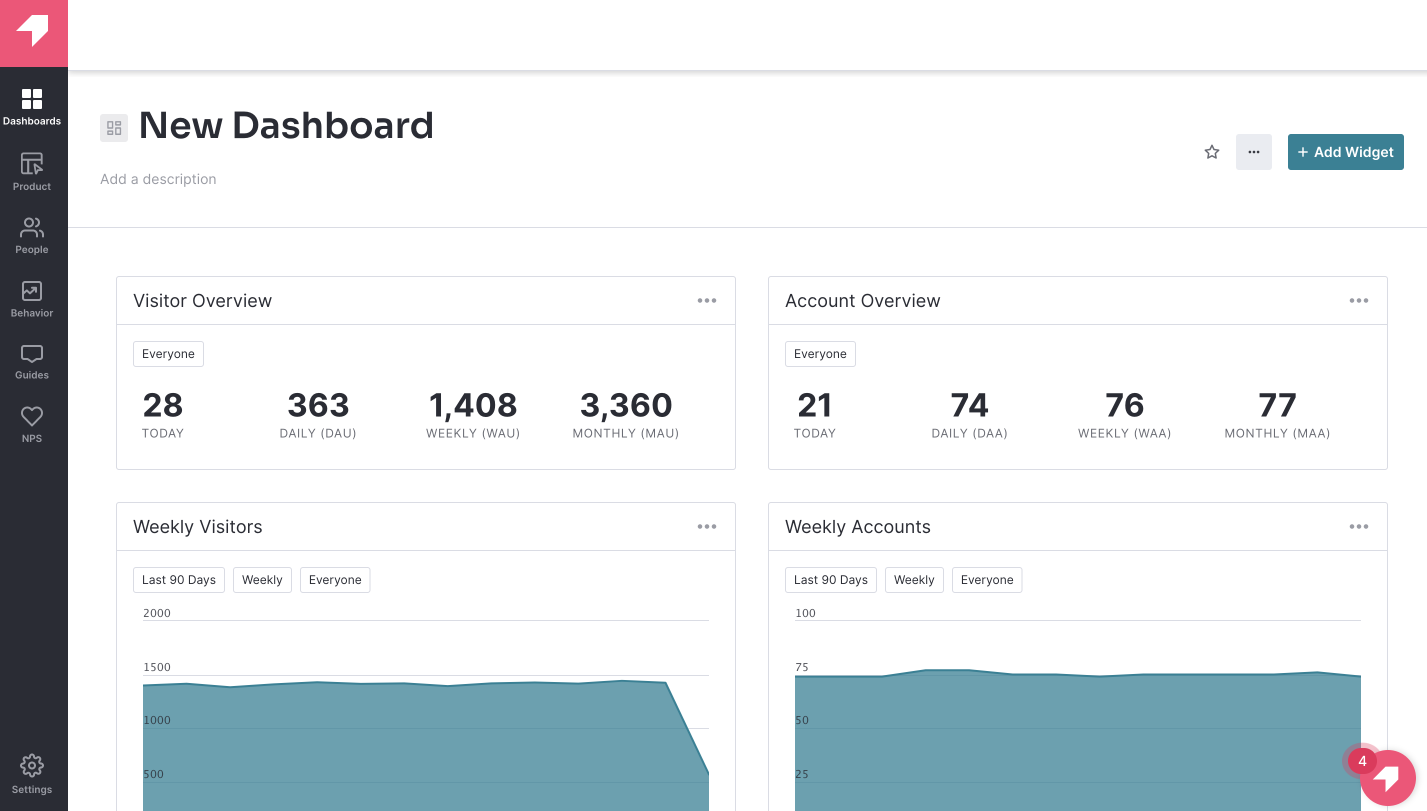
Pendo offers polls (also called micro surveys at Userpilot) through their guides which collect user feedback and gauge sentiment at different points in the user journey.
Polls come with basic functionality and are available on the free plan. However, if you want to collect user sentiment with NPS surveys, you’ll need a paid plan that doesn’t come cheap at all.
Here’s how you can collect user sentiment feedback with Pendo:
- Add short polls on your guides and UI patterns built with Pendo.
- You can use only text polls, yes/no polls, numbered scales, or multi-choice polls and add them as building blocks when building the guides.
- There’s not a lot of customization, like themes or emojis available, but it’s enough to collect data in-app.
- If you are willing to pay for the Growth plan, you get access to Pendo’s NPS feature too.
The downside of using Pendo for collecting user feedback is that you can’t use the insights to personalize the user experience. For example, you can’t create user segments based on NPS scores or specific answers you collect with your polls.
Considering the price you have to pay for Pendo, you’d expect more from it.
If you want to both collect and act on user feedback, you should use a better tool. And, with the risk of sounding biased, Userpilot gives you more value for money here. You can build micro surveys, embed Typeform long surveys, collect and analyze NPS responses, and segment users based on scores and responses so you can trigger more personalized experiences.
Get a Userpilot demo here.
Pros of Pendo?
Despite the price and its steep learning curve, Pendo does have a few pros compared to its competitors.
- Pendo is known for its good and easy-to-use analytics tools like Paths, Retention, and Funnels. (As of Q1 2023, Userpilot will have the same analytics features, with more robust functionality).
- Pendo has a shareable product-planning tool to organize customer feedback and prioritize high-value features. It helps keep teams aligned with the shared feature-planning guide.
- It works on web apps and mobile apps so if you need both, this might be a good choice for you.
Cons of Pendo?
Surprisingly for a product engagement tool that claims to be “all in one” you can’t act directly on the user analytics from Pendo in Pendo.
That’s because Pendo doesn’t allow you to target users segmented by in-app events with the in-app guides you’ve built with it.
Here’s a short list of Pendo’s cons:
- It doesn’t allow you to trigger experiences based on in-app events either. This is probably because of tech debt – but makes Pendo’s analytics pretty much NOT actionable.
- Pendo offers limited onboarding elements, which means you can’t always create the best experience for your users. If you want checklists these can only be accessed from the Resource Center which defeats the purpose of having them in the first place.
- Pendo’s pricing is only available to you if you ask for a quote. The company doesn’t list pricing on its site for the higher tiers. However, some reviews say they have prices starting at $20,000-$25,000 per year for a single product, and around $50,000 per year for the mid-tier package. This might be Pendo’s biggest downside.
If you’re looking for a tool that shows you user analytics in real-time and allows you to trigger in-app experiences based on in-app events and user behavior in real-time – Userpilot offers these features (and at a lower price tag too).
What do users say about Pendo?
Users appreciate Pendo’s analytics but find it complex for building in-app guidance using the guides feature.
As soon as it has been integrated, Pendo is easy to use and manage without the need for developers. I also like that usage is captured retrospectively and the dashboard views or ability to segment users/accounts based on different criteria is really powerful. The guides are great and multi-functional making it really simple for Product Managers to help users navigate with walkthroughs, or post announcements or poll users; they allow Product Managers to get creative with how they engage and interact with users directly in the product. – Parita P.
The best feature about Pendo has been the constant collection of User clicks without the need to set up trackers via code. This enables us to tag the usage directly from the tool and start monitoring historic data without having to involve development teams.- Joseph E.
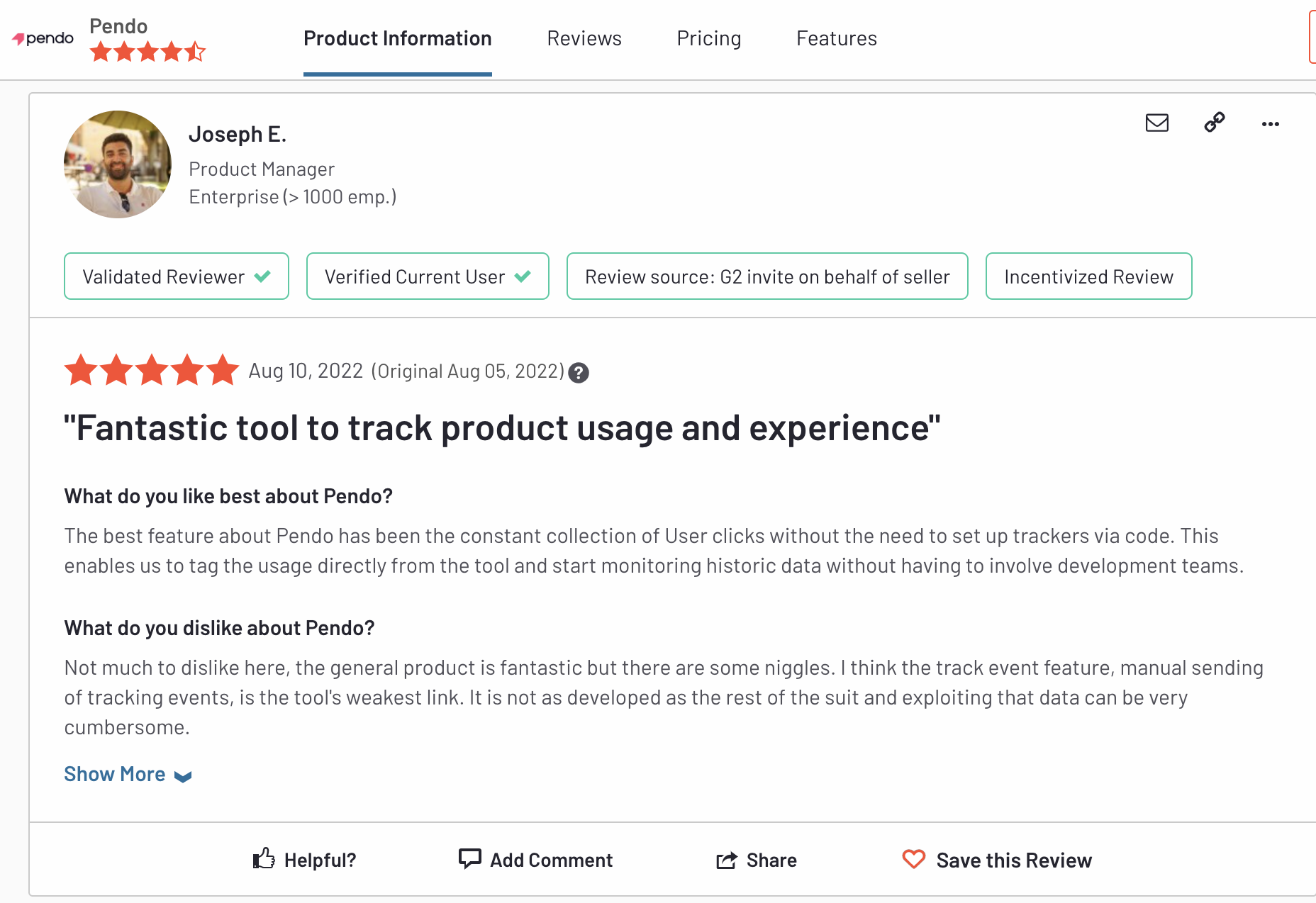
Most users complain about the lack of granularity in analyzing data and the price.
Not much to dislike here, the general product is fantastic but there are some niggles. I think the track event feature, manual sending of tracking events, is the tool’s weakest link. It is not as developed as the rest of the suit and exploiting that data can be very cumbersome.- Joseph E.
And there’s more:
While reports are thorough, a little more granularity would be welcomed. I don’t like that Feedback is a separate cost, as it is a very powerful tool to find out what users want to see in future releases.- Rob S.
And there’s more:
Need to be able to drill more into the Dashboard widgets. For example, using the Stickiness Metrics widget of WAU vs MAU is valuable but I should be able to click into these widgets to figure out which specific Clients these are referring to by different segments. This would be helpful information to hand over to other teams like Customer Success. It would also be helpful to be able to see which Clients are not using certain features when using the Behavior section to create reports. For example, if a CSM has 30 accounts and we can see that 14 are using a specific feature, having a quick list of the 16 not using the fea -Computer Software Admin.
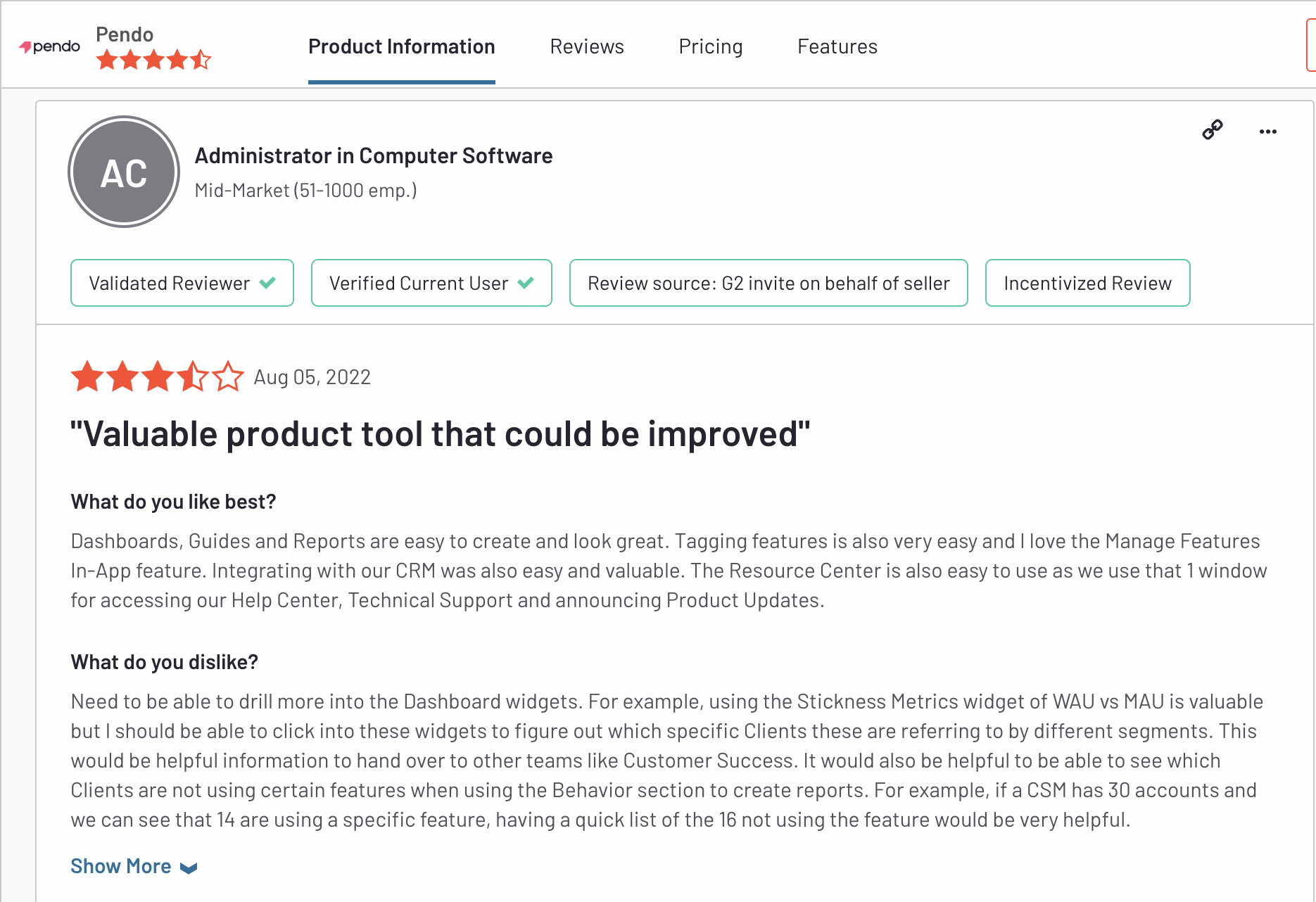
Is Pendo the right fit for your business?
Pendo shines when it comes to analytics, but that’s kind of its main superpower. Here are the top three reasons why you should be looking for an alternative.
- If you only need analytics, there are more affordable tools out there with better functionality too.
- If you want to build more than simple in-app guides and trigger them contextually, Pendo is not the best tool due to its basic guides functionality.
- Not convinced? The price in itself should be the main reason why Pendo is not the best solution.
Pendo pricing
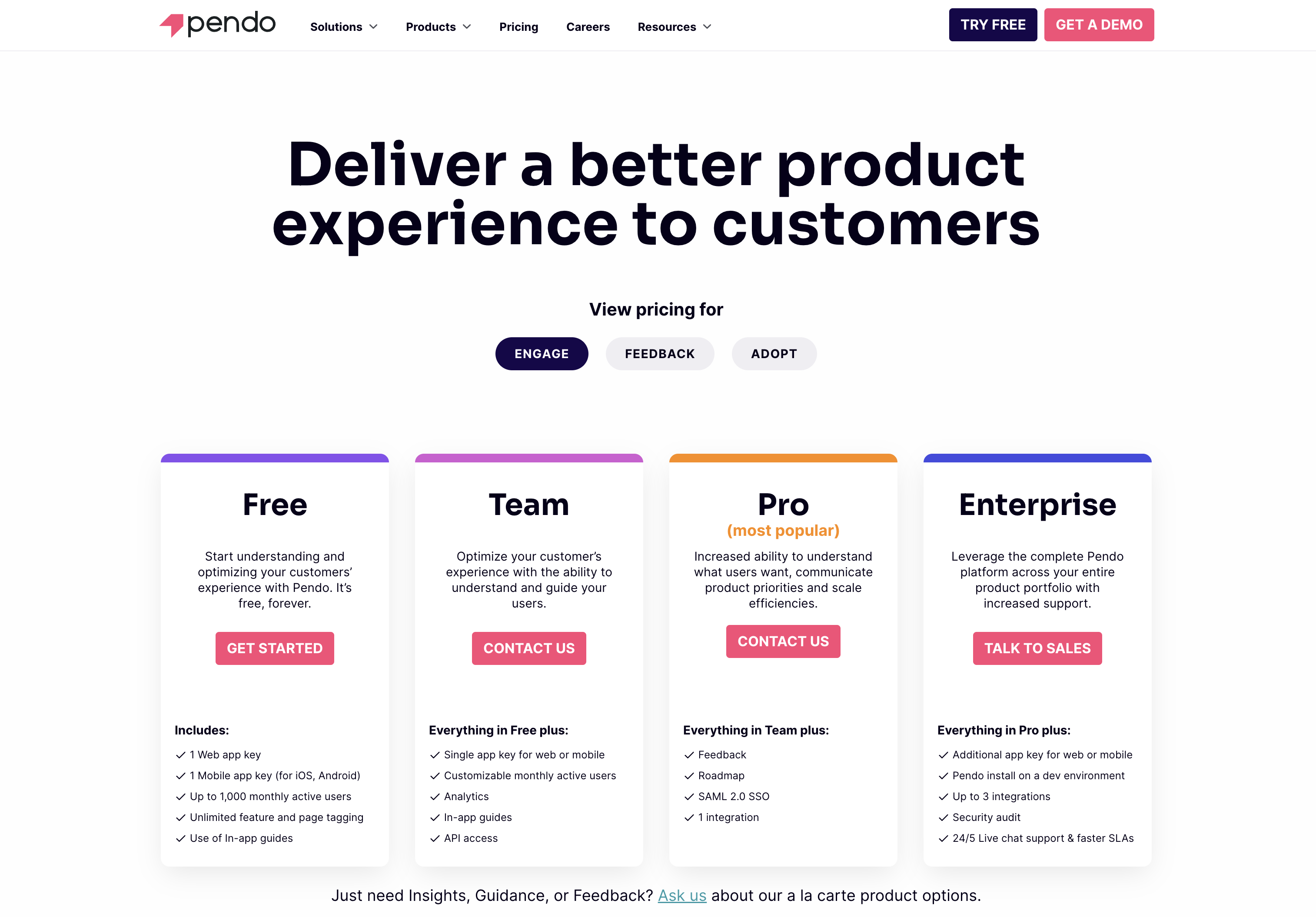
Pendo’s pricing is only available to you if you ask for a quote. The company doesn’t list pricing on its site for the higher tiers. However, some reviews say they have prices starting at $20,000-$25,000 per year for a single product, and around $50,000 per year for the mid-tier package.
The tricky part when it comes to Pendo’s pricing is that you get to pay separately for different modules:
- Pendo Free: up to 500 MAU, single-app, and basic functionality and analytics.
- Pendo Starter $7000/year: 2,000 MAU limit, multi-app, and access to premium features like NPS but it doesn’t include advanced analytics or integrations
- Pendo Growth: Custom MAU, single-app, NPS and PES, resource center, and access to support compared to lower plans
- Pendo Portfolio: Custom MAU, multi-app, cross-journey reports, experimentation, and 1 free integration included.
- Pendo Premium: Custom MAU, multi-app, everything in other plans plus custom roles and permissions and advanced security
- Pendo Feedback: collecting feature requests is a separate module with custom pricing.
- Pendo Adopt: employee onboarding is a separate module with custom pricing
![]()
There is a better tool for your SaaS than Pendo!

Whatfix for customer feedback
Whatfix is one of the top digital adoption platforms around and a driver of innovation in this space.
The software allows you to create user flows, knowledge bases, and task lists to get new users engaged and learning. On top of this, their analytics platform is easy to understand and helps you keep track of behavior analytics, guidance analytics, and user feedback all in one place.
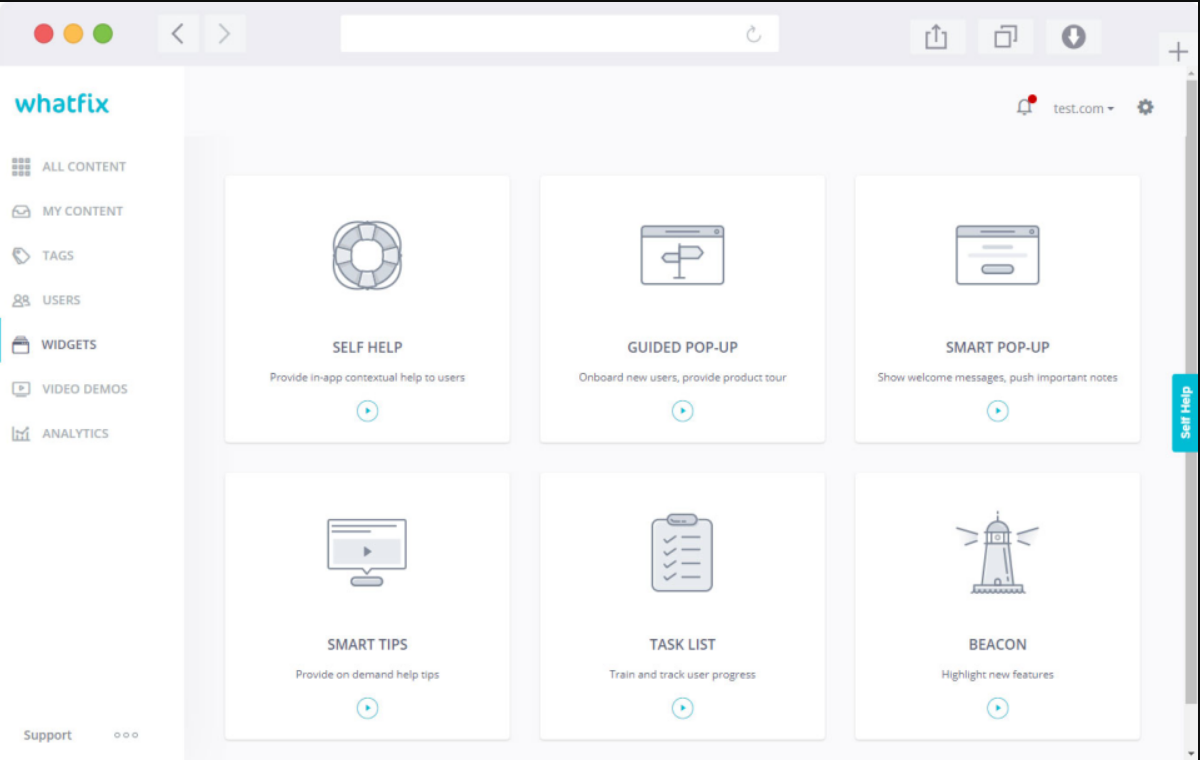
If you want to collect user feedback on specific interactions, Whatfix is a good tool to build micro surveys for that
Here’s how you can collect user feedback with Whatfix:
- With user surveys, you can collect feedback on the onboarding tours and training flows, so you can continuously improve your product support.
- Whatfix’s in-app feedback surveys make it easy to gather feedback and insights from users in real-time.
- Add a follow-up question to enable open-minded feedback
- Send push reminders to customers so they don’t forget about providing feedback
However, if you want to build traditional NPS surveys with response tagging capabilities, then segment customers based on their feedback, Whatfix might not be the best fit for you. This is something that Userpilot offers.
Pros of Whatfix
There are many advantages when it comes to choosing Whatfix. Here are its pros.
- Easy to create flows, even for non-technical team members.
- Allows you to develop knowledge bases for self-help solutions.
- Ideal for both customer and employee onboarding.
Cons of Whatfix
But at the same time, Whatfix has some cons so it’s better to get an overview if you’re thinking of buying it:
- User experience issues, including bugs and sometimes spotty customer service.
- Fewer analytical features and views than you might like.
- Lacks in-depth style customizations.
- It’s difficult to integrate some of the scripted code in the admin integration sections without the help of a Whatfix support team member.
- No free trial option despite it being stated on the homepage.
- It’s targeted at enterprise accounts so small companies might get ignored.
What do users say about Whatfix?
Overall, Whatfix is a good tool and customers are happy with the product. Here is what their customers say about the product.
Our Whatfix Customer Success Manager Kritika has been amazingly responsive to our questions and creative in finding solutions.
Their team really helped us during a project we were doing, and I think they would be great for any company looking for help. This is a must to onboard customers and drive retention.
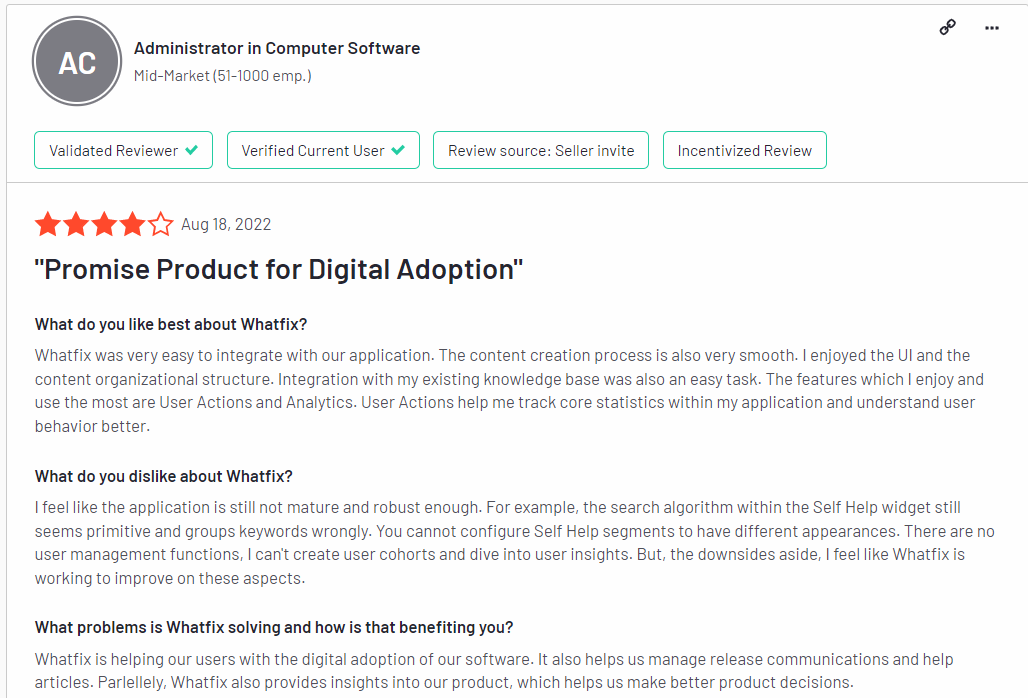
Though Whatfix is considered a solid tool in the market some people have complaints. Mostly they are related to complications for non-technical people and instability.
Here is what they say:
We were promised a lot of features that weren’t as easy to use as they made it seem when we signed up.
The tool itself is challenging for the less technical people to use the tool, as you need to know the css classes to show flows and steps.
unexpected issues and roadblocks in implementation that can cause delay or a need for an alternate approach
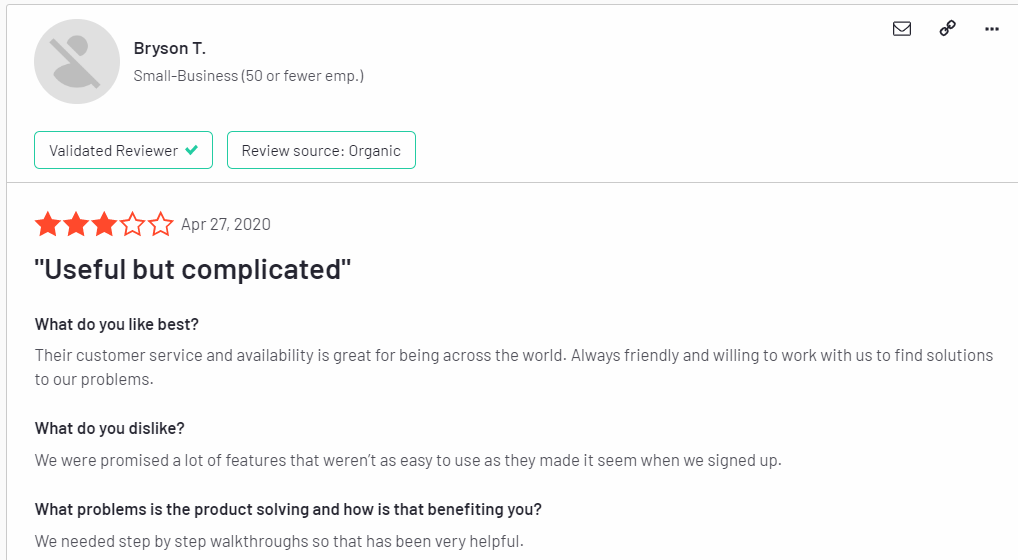
Is Whatfix the right fit for your business?
Though Whatfix is a good tool for user/employee onboarding and it’s used by many companies, there are still some logical reasons why you might look for an alternative:
- It’s designed for enterprise companies and the pricing reportedly starts from $1200/per month. So it’s not something you’ll be delighted to buy if on budget.
- Whatfix doesn’t support NPS surveys so you can’t collect user feedback and measure customer loyalty
- Though you can create onboarding flows, tooltips, and beacons with Whatfix, there are many cost-efficient tools in the SaaS market that provide the same or even more functionality with customization options at a much lower cost.
Whatfix pricing
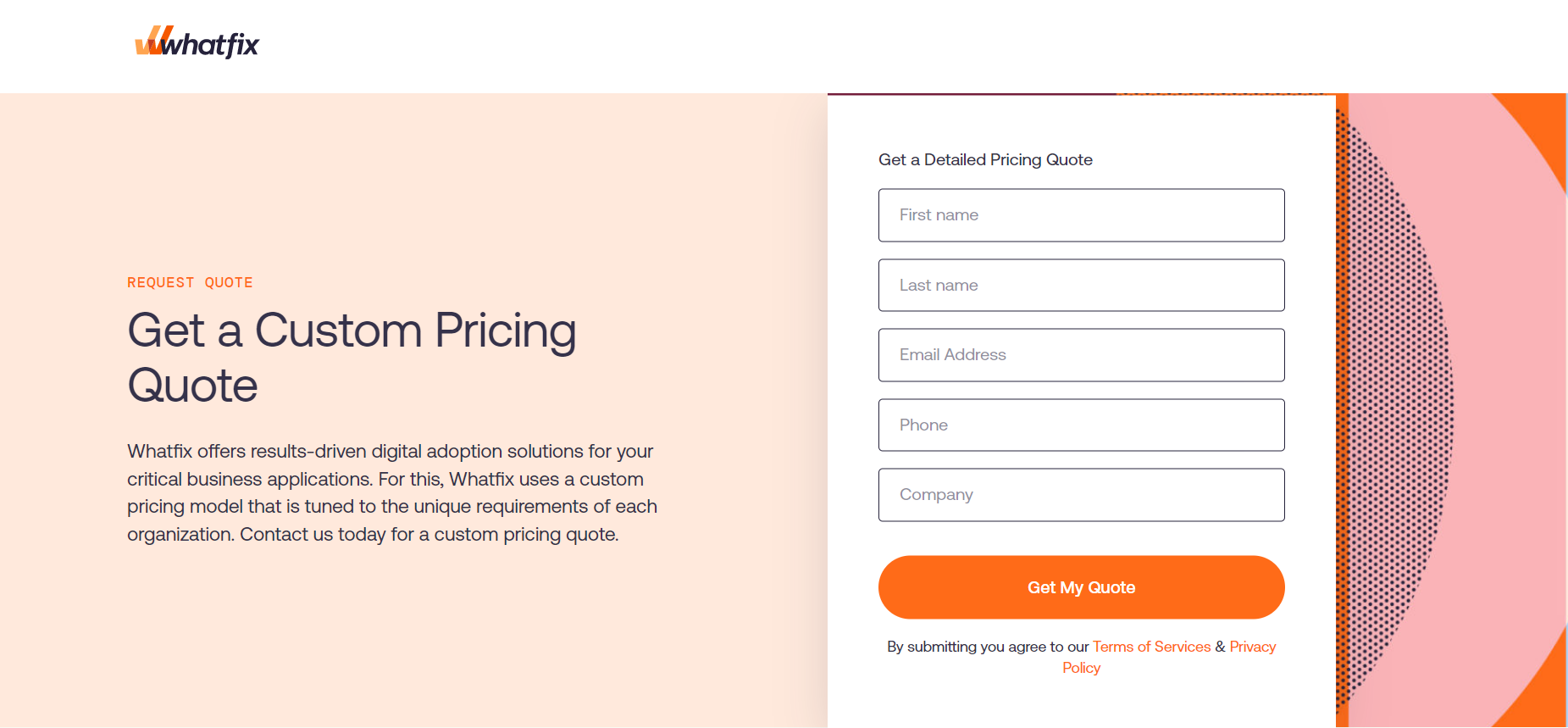
Whatfix doesn’t have any pricing plans on its website. Instead, you’ll need to speak with one of their team members to get a custom quote tailored to your needs and organization.
Otherwise, you can request a free trial to see if Whatfix works for you.
![]()
There is a better tool for your SaaS than Whatfix!

Is there a better alternative for customer feedback?
Pendo and Whatfix are good tools for customer feedback. We’ve seen how they compare to each other and what you can achieve with them. Call us biased, but if you’re looking for something better, Userpilot offers more value for your money than these tools.
Userpilot for customer feedback
Userpilot is a powerful product adoption platform that enables you to quickly build personalized, flexible, contextually relevant in-app experiences targeted to different user segments – all without writing a line of code.

There are two types of feedback you should be focusing on collecting to better understand the health of your product and users.
First, you have user sentiment which looks at user satisfaction and effort scores or loyalty (using NPS surveys). Then you may also want to collect feedback on the functionality of the product or specific features.
You can do all these with Userpilot. In short, you can:
- Collect and track (NPS) in-app with a built-in NPS widget that allows you to fully customize the survey look and feel, and set the trigger frequency and specific targeting.
- Analyze NPS scores, tag responses, and use the data to create specific user segments.
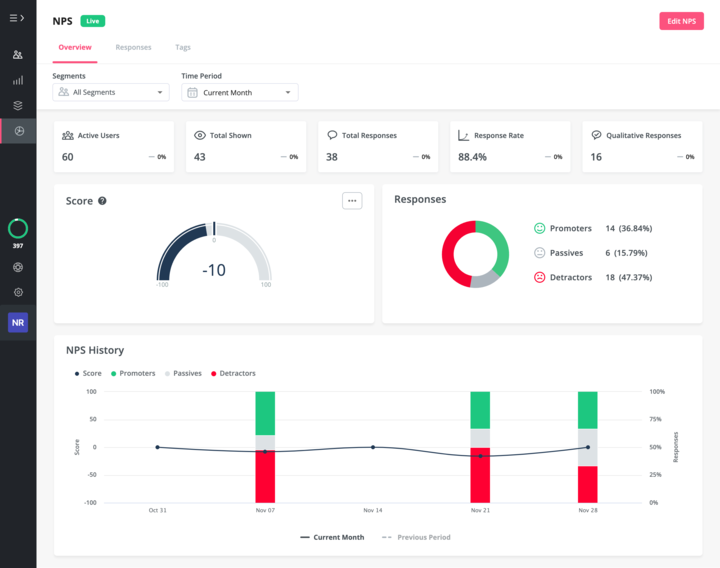
- Build and trigger in-app micro surveys like the classic PMF survey, or similar ones and mix multi-choice and open-ended types of questions to collect specific insights.
- Be in charge of who gets which survey type and when with advanced segmentation capabilities, and of course, you can use the answers to segment your audience.
The advantage of using Userpilot for collecting feedback over other survey tools is that you can better control who sees the surveys but also you can instantly use the data collected to segment your user base and trigger the right experience for them.
For instance, if your users give you a low NPS score because they think you’re missing a critical feature (that you actually have already), you can push an interactive walkthrough guiding them to find and explore this feature.
Pros of Userpilot
Userpilot has a number of advantages, especially for mid-market SaaS companies looking for a robust but at the same time very easy-to-use, no-code tool for user onboarding, product adoption, and simplified product analytics. Let’s have a look at the pros of using Userpilot:
- No-code builder – Userpilot comes with an easy-to-use Chrome Extension builder.
- Multiple UI patterns – choose from a range of options to build customized flows: modals, slideouts, banners, tooltips, hotspots, and checklists are all at your disposal
- UI patterns are not limited by plan – you get access to all of them on every single plan, meaning you get value even with the Traction plan (this is the entry-level one).
- Engaging walkthroughs and onboarding flows- build interactive walkthroughs targeted to distinct user segments.
- In-app help – build a resource center offering self-service support to your users, customize it with your branding, and select from a range of help options to boost user satisfaction (i.e. videos, in-app flows, chat, and more).
- Experimentation – built-in A/B testing for flows lets you explore and quickly iterate based on direct user behavior.
- Powerful feedback options- integrated NPS surveys with analytics and response tagging unlock insight into how your users feel.
- Advanced analytics and segmentation- analyze product usage and in-app flow engagement and build user segments using the data.
- Event tracking and feature tags- tag UI engagement (clicks, form fills, hovers) and group them into one custom event to track what really matters.
- More value with integrations- unlock value faster with built-in integrations with popular tools like Segment, Amplitude, Mixpanel, Kissmetrics, Intercom, Heap, and more.
Cons of Userpilot
Userpilot has a number of advantages, especially for mid-market SaaS companies looking for a robust but at the same time very easy-to-use, no-code tool for user onboarding, product adoption, and simplified product analytics. Let’s have a look at the pros of using Userpilot:
- No-code builder – Userpilot comes with an easy-to-use Chrome Extension builder.
- Multiple UI patterns – choose from a range of options to build customized flows: modals, slideouts, banners, tooltips, hotspots, and checklists are all at your disposal
- UI patterns are not limited by plan – you get access to all of them on every single plan, meaning you get value even with the Traction plan (this is the entry-level one).
- Engaging walkthroughs and onboarding flows- build interactive walkthroughs targeted to distinct user segments.
- In-app help – build a resource center offering self-service support to your users, customize it with your branding, and select from a range of help options to boost user satisfaction (i.e. videos, in-app flows, chat, and more).
- Experimentation – built-in A/B testing for flows lets you explore and quickly iterate based on direct user behavior.
- Powerful feedback options- integrated NPS surveys with analytics and response tagging unlock insight into how your users feel.
- Advanced analytics and segmentation- analyze product usage and in-app flow engagement and build user segments using the data.
- Event tracking and feature tags- tag UI engagement (clicks, form fills, hovers) and group them into one custom event to track what really matters.
- More value with integrations- unlock value faster with built-in integrations with popular tools like Segment, Amplitude, Mixpanel, Kissmetrics, Intercom, Heap, and more.
What users say about Userpilot

Let’s check what real users like about Userpilot.
Userpilot is an incredible, user-friendly software that allows us to create unforgettable experiences for our clients! From basic to complex experiences, we have been able to do them all with ease! I would highly recommend this software to anyone who wants to provide their clients or users with the best product tour experience. The possibilities of what you can create are endless! – Tayla G.
Userpilot is simple to set up, use, and does not require any dev – which means instant publishing. This is critical for us as a SaaS company that releases new features frequently; we need the ability to inform our customers of changes quickly, and doing this in our platform through Userpilot allows us to reach the right audience, at the right time, in the right place. There have been many awesome extra features we’ve discovered since coming on board, and it’s been great to see new features released frequently. The tool itself is intuitive and reliable. Having used similar products previously that were clunky and buggy this has really made us happy with our decision to move to Userpilot. – Melina K.
![]()
Get more value for your money with Userpilot!

Userpilot pricing
Userpilot’s transparent pricing ranges from $249/month on the entry-level end to an Enterprise tier for larger companies.
Furthermore, Userpilot’s entry-level plan includes access to all UI patterns and should include everything that most mid-market SaaS businesses need to get started.

Userpilot has three paid plans to choose from:
- Starter: The entry-level Starter plan starts at $249/month and includes features like segmentation, product analytics, reporting, user engagement, NPS feedback, and customization.
- Growth: The Growth plan starts at $749/month and includes features like resource centers, advanced event-based triggers, unlimited feature tagging, AI-powered content localization, EU hosting options, and a dedicated customer success manager.
- Enterprise: The Enterprise plan uses custom pricing and includes all the features from Starter + Growth plus custom roles/permissions, access to premium integrations, priority support, custom contract, SLA, SAML SSO, activity logs, security audit, and compliance (SOC 2/GDPR).
Conclusion
And that’s a wrap! We hope this overview gave you in-depth insights into both Pendo’s and Whatfix’s functionalities and helped you make up your mind.
As we already discussed, both tools come with advantages and disadvantages so there isn’t one that is the best. It totally depends on your product needs and budget. If you want the best value for money, going with the alternative option would be our recommendation. Want to see how Userpilot can help with customer feedback? Book a demo below.
![]()
There is a better tool for your SaaS than Pendo!


